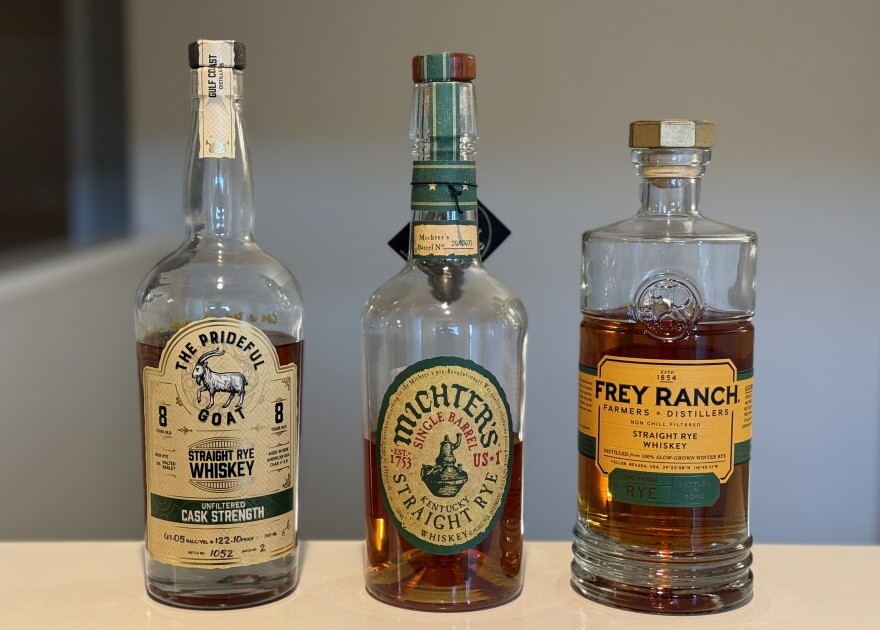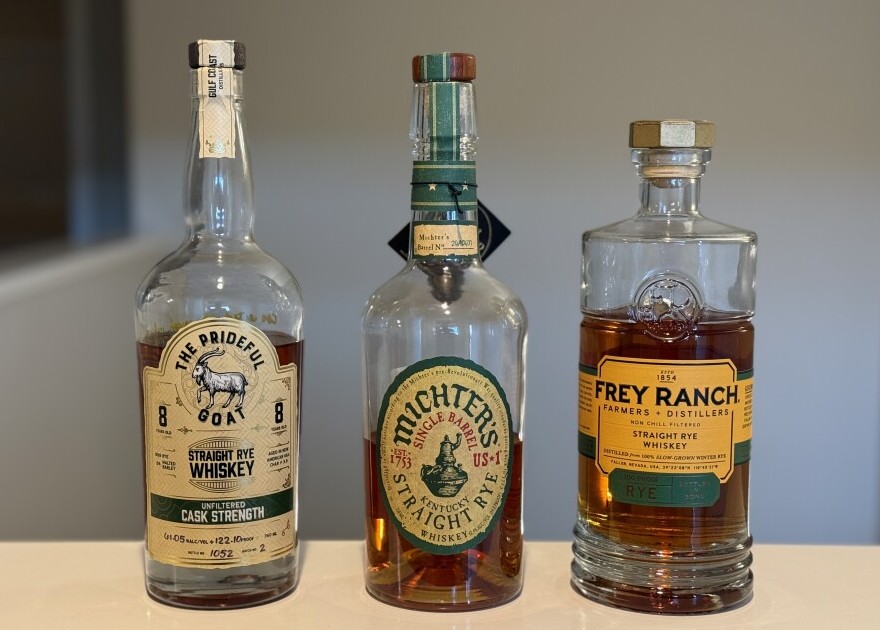Rye whiskey has long been intertwined with iconic images of the American West, where cowboys could be seen tipping back a glass after a long day’s ride. It’s a drink that’s also etched into the gritty underbelly of detective novels, often sipped by rugged characters who navigate the shadowy streets of noir stories. This shadowy, rustic reputation has, rightly or wrongly, sometimes overshadowed rye’s sophistication.

What Makes Rye Whiskey Unique Compared to Other Whiskeys?
Rye whiskey stands out due to its bold, spicy flavor profile, which comes from its mash bill containing at least 51% rye grain. This distinguishes it from bourbon, which leans sweeter due to its corn content, and wheat whiskey, which has a softer, smoother character. Rye’s peppery notes, hints of cinnamon, clove, and anise, along with its robust, dry finish, make it a favorite for those seeking complexity and depth. Its versatility in both classic cocktails like the Manhattan and Sazerac, and its resurgence in craft distilling, highlight rye whiskey’s unique place in the spirits world.
In recent years, rye whiskey has emerged from these shadows, reclaiming its place in the pantheon of classic cocktails. Mixologists and enthusiasts alike have embraced its complexity, using it to craft drinks that are both nostalgic and contemporary. The Manhattan, perhaps the most renowned rye-based cocktail, is a testament to this kind of sophisticated blend of flavors. By combining rye’s inherent spiciness with sweet vermouth and a splash of bitters, it transforms into a drink that embodies balance and finesse.
Rye’s resurgence in the cocktail scene isn’t just about nostalgia—it’s about versatility. Its peppery notes and robust profile provide a canvas for a myriad of flavors. Whether it’s the citrus-forward complexity of a Ward 8 or the absinthe-tinged allure of a Sazerac, rye whiskey proves itself again and again as an adaptable base spirit.
For those venturing into the world of whiskey, trying rye is a fantastic starting point. It’s often a bit less sweet than bourbon, but with an engagingly spicy character that can appeal to both newcomers and seasoned whiskey drinkers. And if you’re looking to try your hand at making some classic cocktails at home, rye whiskey can be your trusty sidekick, adding depth and character to your concoctions.
Main Points
- What Makes Rye Whiskey Unique Compared to Other Whiskeys?
- Rye Whiskey Demystified: Understanding Its Core
- The Distinct Edge of Rye: A Comparison With Other Whiskeys
- Historical Roots to Modern Revival: Rye Whiskey’s Journey
- Some of My Favorites
- The Modern Rye Renaissance: Variants, Tastes, and Toasts
Rye Whiskey Demystified: Understanding Its Core
Rye whiskey is defined by its bold use of rye grain, constituting at least 51% of its mash bill. This grain is what distinguishes it from other types of whiskey, like bourbon, which must contain at least 51% corn, or wheat whiskey with its majority wheat blend. Despite these differences, rye whiskey shares some production similarities with bourbon, particularly in the aging process where both are left to mature in charred new oak barrels.
Understanding rye whiskey’s construction is crucial to appreciating its unique flavor profile. The density of rye contributes a signature spicy taste that makes it stand out, giving notes of cinnamon, clove, and anise. This contrasts sharply with the sweeter, smoother flavors typical of bourbon. These characteristics attract whiskey aficionados looking for a spirit with a bit more bite and complexity.
If you’re navigating the whiskey aisle and trying to distinguish among these spirits, looking at the mash bill is a practical first step. While the predominant grain is a key differentiator, the type of barrels and aging process also play essential roles in flavor development. Rye’s time in charred oak barrels infuses it with layers of flavor, including caramel and toffee undertones that balance its spicy front.
For those eager to experiment with different whiskey styles, comparing rye to its bourbon and wheat counterparts can be eye-opening. The distinct flavor profiles can guide your choices in cocktails or neat sips alike. Whether you prefer the spicy character of rye or the sweetness of a corn-heavy bourbon, understanding these nuances helps enhance your whiskey experience.
The Distinct Edge of Rye: A Comparison With Other Whiskeys
Rye whiskey stands out in the whiskey world, even when compared to high-rye bourbons that flirt with spicy undertones. Although they share some similarities, high-rye bourbons like Basil Hayden’s don’t meet the strict criteria to be labeled as rye. They pack a punch in their own right, but true rye whiskey is on a league of its own due to its superior rye content.
Understanding the landscape of whiskey means recognizing how different regulations impact the final product. Canadian rye whiskey is a prime example of these quirks. Despite the name, Canadian whiskey isn’t required to contain actual rye, a throwback to older regulations that were more about tradition than content. This makes checking labels crucial if you’re after authentic rye whiskey experiences.
What really makes rye whiskey unique is its challenging production process. Distillers tackling rye face notoriously sticky mash due to compounds like beta-glucans and arabinoxylans that can wreak havoc in the mash tun. These challenges result in a product with character; the rye’s spiciness and complex flavors are more pronounced due to the effort it takes to master this grain.
For anyone venturing into whiskey tasting, understanding these differences is beneficial. Knowing why some whiskeys have more spice or less sweetness—or why Canadian rye might differ significantly from its American cousin—can enhance your appreciation for the craft behind each bottle. Whether you’re a seasoned aficionado or a curious newcomer, these insights can make your journey through the world of rye whiskey all the more rewarding
Historical Roots to Modern Revival: Rye Whiskey’s Journey
Rye whiskey has a rich history that dates back to early America, finding its strength in the hardy crops cultivated by German settlers. These settlers brought their knowledge of rye farming, making the grain a staple for whiskey production in regions like Pennsylvania, West Virginia, and Maryland. Known for its resilience, rye became a favorite among distillers who sought to create robust whiskeys full of character.
As British taxes on molasses made rum production less viable, rye whiskey stepped into the spotlight, swiftly becoming a popular spirit. The Monongahela variety from the mid-Atlantic states captured the nation’s taste buds with its distinct blend, while Maryland-style rye incorporated more corn, offering a flavor profile reminiscent of a high-rye bourbon.
Despite its early success, rye whiskey faced significant challenges during Prohibition. The once-thriving market collapsed, and even after prohibition ended, federal subsidies favoring corn, along with the appeal of clear spirits like vodka and gin, kept rye whiskey from reclaiming its former glory. Brands like Old Overholt persisted through these tough times by adapting to changing tastes and regulations.
In recent years, a renewed interest driven by craft distilleries has catalyzed rye whiskey’s modern revival. Enthusiasts of Prohibition-era cocktails have rediscovered rye’s unique flavor, inspiring a resurgence in its production and popularity. This period also aligns with a broader movement towards diverse grain usage, encouraging more distinct and environmentally friendly whiskey production.
For whiskey lovers and the environmentally conscious, rye’s story is one of resilience and reinvention. Its return speaks to the changing tastes and appreciation for spirits with depth and complexity. As it continues to evolve, rye whiskey offers a fascinating glimpse into both the past and future of the spirits world.
Some of My Favorites

Here are three of my favorite Rye Whiskeys that showcase the diverse flavors and craftsmanship in the world of rye:
- Michter’s Single Barrel Rye
Known for its rich, smooth character, Michter’s Single Barrel Rye offers a balanced blend of spice, vanilla, and caramel with a hint of citrus. Each barrel brings subtle variations, making every bottle a unique tasting experience. - Frey Ranch Straight Rye
Crafted from 100% rye grown on their Nevada farm, Frey Ranch delivers a bold, earthy profile with notes of cinnamon, clove, and pepper, balanced by a touch of honeyed sweetness. Its farm-to-bottle approach highlights the grain’s natural character. - The Prideful Goat 8-Year Straight Rye Single Barrel
Aged for eight years, this single-barrel rye offers a complex mix of dark fruit, toffee, and baking spices with a lingering, warm finish. Its well-aged depth makes it a standout for those who appreciate a robust, flavorful rye.
The Modern Rye Renaissance: Variants, Tastes, and Toasts
Rye whiskey is enjoying a vibrant comeback, marked by innovation and enthusiasm not seen since its early days. This modern renaissance is fueled by distillers who push boundaries with variants that offer new takes on this classic spirit. Innovations like malted rye whiskey blend tradition with creativity, as seen in products from distilleries like Rogue, which balance rye’s spiciness with barley’s smoothness.
Today’s rye whiskey world offers more than just straight rye. The market is filled with unique takes like flavored Rock and Rye, which harkens back to the original rock candy-sweetened spirits. Such variations attract both old-school rye fans and newcomers eager to explore different flavor profiles.
Award-winning ryes are part of this boom, capturing attention worldwide. Experiments with finishing processes, such as aging in rum or cider casks, enhance complexity and depth. Whiskey enthusiasts can sample such celebrated expressions as Redemption Plantation Rum Cask Finished Rye or WhistlePig’s The Boss Hog VII: Magellan’s Atlantic, both lauded for their unique flavor characteristics.
Classic rye cocktails have also risen in popularity alongside these innovations. The spicy essence of rye complements traditional mixed drinks like the Sazerac or the simpler Whiskey Ginger, broadening their appeal to a new generation of drinkers.
Whether sipping neat or stirred into a cocktail, rye whiskey delivers on complexity and versatility. Its evolution from historical significance to a staple of the contemporary cocktail scene ensures that it remains an essential component of any whiskey collection. Rye’s story is one of transformation, illustrating the endless possibilities of grain-to-bottle creativity.
If this guide sparked your curiosity about rye whiskey, why not take the next step? Share your favorite rye or cocktail creations in the comments—I’d love to hear what you’re sipping! And if you’re eager to keep exploring the rich world of whiskey, subscribe to Dram Discoveries for more in-depth guides, reviews, and stories. Cheers to your next pour! 🥃
About Jim
Jim is the creator of Dram Discoveries, a blog dedicated to exploring and celebrating the world of whiskey. With over six years of experience, he combines a passion for whiskey’s craft and culture with a love for connecting enthusiasts through tastings, stories, and shared discoveries. For Jim, whiskey is more than a drink—it’s a journey of camaraderie, learning, and lifelong appreciation.
There are no affiliate links in this post.


Rye whiskey’s rich history and bold, spicy profile make it a standout in the whiskey world. From the saloons of the Wild West to the refined craft cocktail bars of today, it has remained a symbol of character and complexity. Whether sipped neat or mixed into a Manhattan, rye brings a depth of flavor that continues to captivate whiskey lovers old and new. Here’s to its timeless appeal and ever-evolving legacy!
Herman,
Thanks for sharing such a thoughtful comment! You’ve perfectly captured the essence of rye whiskey—its bold character and rich history really do make it stand out. It’s amazing how it continues to evolve while staying true to its roots. Cheers to that timeless appeal!
Cheers!